
The Corps of Royal Marines (RM) is the amphibious light infantry and one of the five fighting arms of the Royal Navy. The Royal Marines were formed in 1755 as the Royal Navy's infantry troops. However, the marines can trace their origins back to the formation of the English Army's "Duke of York and Albany's maritime regiment of Foot" at the grounds of the Honourable Artillery Company on 28 October 1664.

USS Langley (CV-1/AV-3) was the United States Navy's first aircraft carrier, converted in 1920 from the collier USS Jupiter (AC-3), and also the US Navy's first turbo-electric-powered ship. Conversion of another collier was planned but canceled when the Washington Naval Treaty required the cancellation of the partially built Lexington-class battlecruisers Lexington and Saratoga, freeing up their hulls for conversion to the aircraft carriers Lexington and Saratoga. Langley was named after Samuel Pierpont Langley, an American aviation pioneer. Following another conversion to a seaplane tender, Langley fought in World War II. On 27 February 1942, she was attacked by nine twin-engine Japanese bombers of the Japanese 21st and 23rd Naval Air Flotillas and so badly damaged that she had to be scuttled by her escorts.

A beach armoured recovery vehicle (BARV) is an armoured recovery vehicle used for amphibious landings.
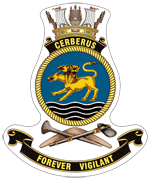
HMAS Cerberus is a Royal Australian Navy (RAN) base that serves as the primary training establishment for RAN personnel. The base is located adjacent to Crib Point on the Mornington Peninsula, south of Melbourne, Victoria, Australia. The base is also an official bounded locality of the Shire of Mornington Peninsula and is the only naval base to have a specific listing in the Australian census. As at the 2016 census, HMAS Cerberus had a population of 1,040.

Landing Helicopter Dock (LHD), is the U.S. Navy (USN), Royal Australian Navy (RAN) and NATO hull classification symbol for multipurpose amphibious assault ships which are capable of operating helicopters and have a well deck. These vessels are built with a full flight deck similar in appearance to an aircraft carrier to operate utility and attack helicopters. Some can also operate tilt rotor aircraft such as the MV-22 Osprey and VSTOL aircraft such as the AV-8 Harrier and the F-35B Lightning II. Examples of this kind of ship include the USN's Wasp class, French Navy's Mistral class and ships of the Spanish Navy's Juan Carlos I class including those designs based on the class, such as the Royal Australian Navy's Canberra class. Other nations also use the designation for their vessels, such as the Republic of Korea Navy for its Dokdo class.
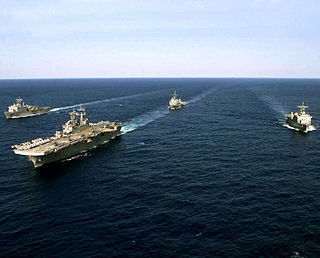
An amphibious ready group (ARG) of the United States Navy consists of a naval element—a group of warships known as an amphibious task force (ATF)—and a landing force (LF) of U.S. Marines, in total about 5,000 people. Together, these elements and supporting units are trained, organized, and equipped to perform amphibious operations.
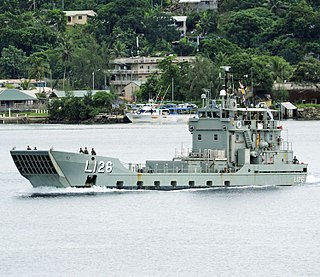
The Balikpapan class is a ship class of eight heavy landing craft. All eight were originally laid down by Walkers Limited for the Australian Army in the early 1970s. A reorganisation of watercraft responsibilities in the Australian military meant the landing craft were to be operated by the Royal Australian Navy (RAN), with seven commissioned directly into RAN service during 1973 and 1974, and lead ship Balikpapan transferred from the army to the navy. During the leadup to the independence of Papua New Guinea in 1975, two of the vessels were transferred to the new Papua New Guinea Defence Force (PNGDF).

A Landing ship, infantry (LSI) or infantry landing ship was one of a number of types of British Commonwealth vessels used to transport landing craft and troops engaged in amphibious warfare during the Second World War. LSIs were operated by the Royal Navy, British Merchant Navy, Royal Canadian Navy, Royal Indian Navy, and Royal Australian Navy. They transported British Commonwealth and other Allied troops in sea assaults and invasions throughout the war.
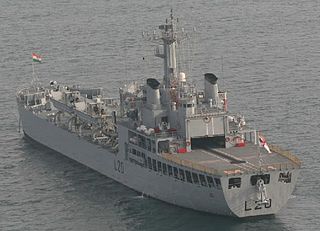
The Magar-class landing ships are amphibious warfare vessels of the Indian Navy, currently in active service. Only two ships of the class were designed and built by Hindustan Shipyard Limited, with fitting completed at Garden Reach Shipbuilders and Engineers.
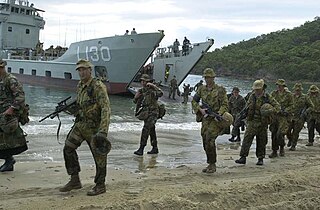
The Royal Australian Navy and Australian Army have operated 24 amphibious warfare ships. These ships have been used to transport Army units and supplies during exercises and operational deployments.
John Monash was a cargo ship operated by the Australian Army between 1965 and 1975.
The Australian landing ship medium Clive Steele was a United States Navy landing ship medium which was later sold to Australia and operated by the Australian Army.
The Landing Ship Medium Mark II was an amphibious warfare ship developed for the Australian Army in the late 1960s. The Army and Royal Australian Navy (RAN) were unable to reach agreement on the ship's specifications and the project was cancelled in the early 1970s.

BRP Ivatan (AT-298) is a Balikpapan-class heavy landing craft operated by the Philippine Navy. One of eight vessels built by Walkers Limited for the Royal Australian Navy (RAN), the ship was commissioned into Australian service in 1973 as HMAS Brunei. During her RAN career, Brunei visited Lord Howe Island, was deployed post-Cyclone Tracy as part of Operation Navy Help Darwin, performed coastal surveys of northern Australia and Papua New Guinea, and served as part of the INTERFET peacekeeping taskforce.












